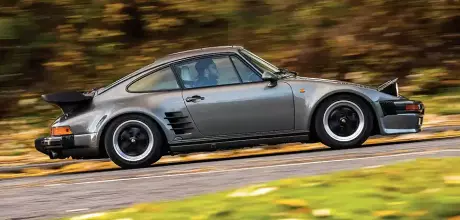Testing a Flachbau-styled 1987 Porsche 911 Turbo 3.3 930
Flachbau holds a special place in the lexicon of Porsche language. Developed for aero effect on the racetrack, the flat-nosed 911 Turbo styling it described became a 1980s icon. With less than a thousand examples built, the real deal is both rare and expensive, which is where this stunning replica comes in...
Words Steve Bennett
Photography Dan Sherwood
LOW PROFILE 930 FLACHBAU AWESOME AUTO TRIMMING
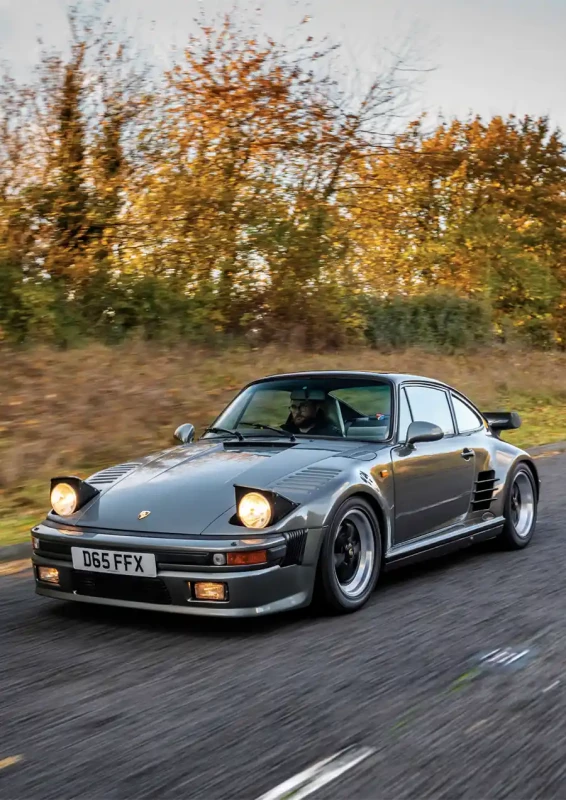
TO MAKE PROPER PROGRESS REQUIRES ANTICIPATION, THEREBY NOT BEING CAUGHT OFF-BOOST AND IN THE WRONG GEAR
Flat nose, slant nose or Flachbau? We’ll take the latter term of reference, chiefly because it sounds more exotic, even if the literal translation from German into English is low rise. Today, then, I’m going to drive a ‘low rise’ Porsche.
Perhaps best not to get too literal. Let’s stick with Flachbau, which has very much become terminology used reverently and expertly in the secret language of true Porschephiles, where authenticity is all. The same can be said of Sonderwunsch, which when decoded, becomes Special Wishes.
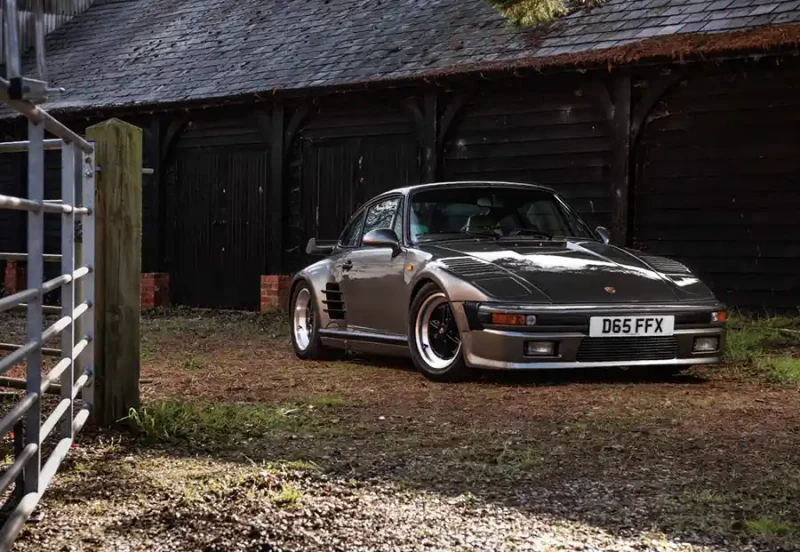
Flachbau and Sonderwunsch are somewhat synonymous with one another. Porsche’s ‘Department S’ was formed in 1981, specifically to fulfil the wishes of Mansour Ojjeh, a Saudi businessman and chairman of the Techniques d’Avant Garde (TAG) private holding company. He held a desire to create a roadgoing version of the 935 endurance racer, recognised for its trademark widebody, massive rear wing and flat-nosed frontage.
Of course, we are talking all things 911 Turbo (930) here. The bloodline is traceable to 1974, when Porsche developed the 930 to qualify the 934 and 935 for Group 4 and Group 5 racing. FIA homologation required a production run of four hundred cars within twenty-four months, but as we know only too well, Porsche gambled on taking the Turbo mainstream, so much so 1,300 930s were built and sold in that two-year period. The nose job arrived during the 1976 season. Although street Turbos carried conventional 911 front ends, Porsche managed to slide a 935 with a new front end through a loophole in Group 5 regulations, thereby avoiding the need for road car homologation. Slicing off the traditional wings and headlamps produced the now iconic Flachbau shape, desired by Weissach’s motorsport engineers for increased downforce.

While Porsche might have been slow to capitalise on applying this racer look to the road going 930, then as now, there were plenty of hot rodders, tuning shops and independent automotive styling houses prepared to do the job for wealthy customers. By 1981, it was abundantly clear Stuttgart was missing out — the aftermarket had effectively stolen lunch from Porsche’s table. Enter then, the persuasive Mr Ojjeh and his very special wish.
What machine it was. Based on the 930, the car was treated to the aforementioned bodywork appendages, a genuine 3.3-litre race derived flat-six, custom Brilliant Red paintwork, a bespoke interior (centred around wood veneer and cream leather Recaro seats), a Clarion component sound-system and unfeasibly wide BBS split rims with gold centres.
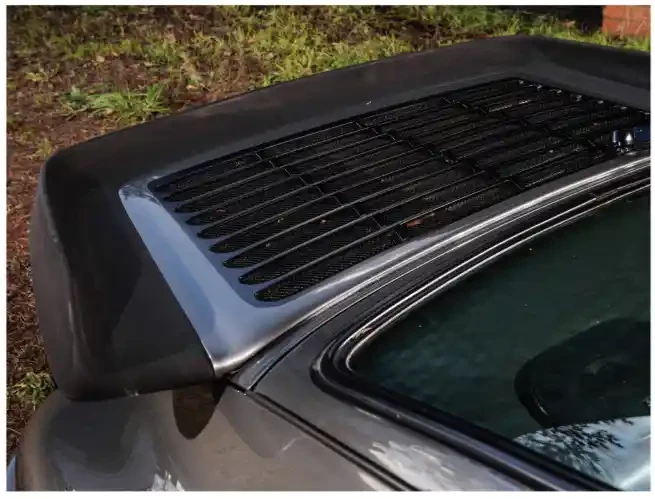
Ojjeh’s build was the first official factory 911 Flachbau, but other wellheeled Porsche customers wanted in. The company therefore plucked standard 930s from the production line — extending the treatment to a few 911 SCs and Carrera 3.2s later down the line — and relocated them to the Restoration Department in Werk 1 (werk being another one of those Porsche references capable of being dropped into conversation to imply great knowledge of the marque), where the metal magic would begin per customer special wishes. The cost of entry to this exclusive club easily doubled the price of the standard 911 Turbo. For the more grounded Porsche enthusiast, there was a whiff of poseur surrounding these hand-built creations, but there was no arguing with the craftsmanship.
SLIPPERY SLOPE
While specification differed between each build, the defining element of the Flachbau was (and still is) the slanting front end, devoid of the standard 911’s pronounced upright wings, oval headlights and plunging bonnet. Early Flachbaus featured headlights in the front valance per the factory race cars providing inspiration. Most customer Flachbaus featured side sill extensions and a wide body, which varied in look and execution from car to car. Likewise, rear wings veered from mild to wild. As befitting of a custom build, there was no standard specification.
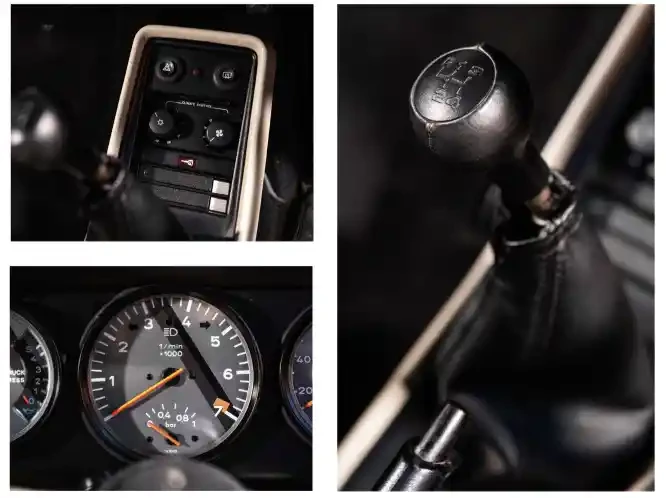
In the wake of Ojjeh’s car, Flachbaus from this period of the early 1980s are considered to be first-generation builds, of which it’s reckoned fifty-eight cars were assembled. Second-generation Flachbaus carried on the good work of the Sonderwunsch programme, but moved toward a more definitive and productionised look, with de facto front spoiler, driving lights and provision for an oil cooler. 944-style pop-up headlights arrived, as did the option for louvres atop the front wings. Sill extensions morphed into the rear wheel arch intakes. Again, styles of rear wing were personal to the customer. Similarly, engines veered from the standard 930’s 300bhp to the Power Kit specification of 330bhp. It’s difficult to nail production figures, but a smidge more than two hundred cars is reckoned to be about right.
930 Flachbaus are in no way production cars, but with experience gained, Porsche saw an opportunity to introduce a 911 Turbo halo model and so devised specification to be cast in production stone. For those desiring exclusivity, cars could still be ‘Sonderwunsched’, but rolling down the Zuffenhausen assembly line was now a 930 S or 930 SE, with fully productionised pressed steel bodywork, pop-up headlights, wing louvres, the previously mentioned front valance and spoiler arrangement, side skirts, slatted rear wing intakes, 3.3 litres of displacement and 330bhp as standard. Sixteeninch staggered Fuchs wheels (seven inches of width at the front, nine at the back) wrapped in low-profile tyres were standard, as were interiors as luxurious as any other performance car of the era. Think air-conditioning and deep-bolstered seats. Final finishing and fettling was carried out in the repair department at Werk 1.
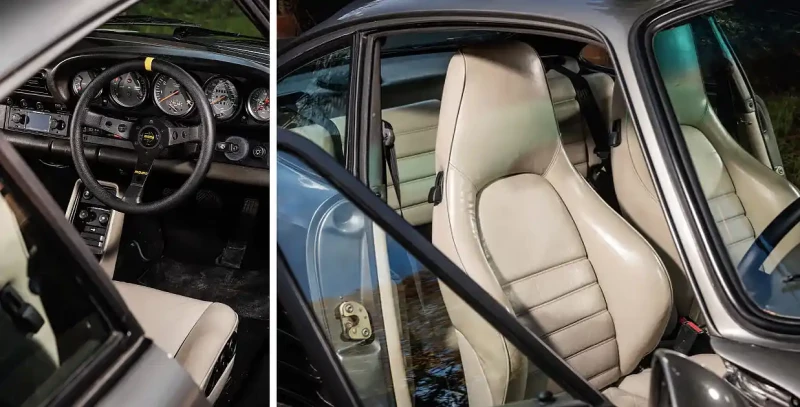
There was scope for modest customisation via individual equipment options, but in truth, Porsche had already thrown most of its toys at this new 911 Turbo halo model, but was it enough to justify a price hike of forty grand over the standard 300bhp 930? In the UK, this equated to £34,000 versus £74,000, a tough pill to swallow. That said, Porsche Cars Great Britain commissioned a 930 SE for its stand at the 1985 Earls Court Motorfair and stole the show, placing the Turbo firmly in Ferrari and Lamborghini poster car territory. The Flachbau was perfect for the glitzy, high-tech, loadsamoney 1980s. Put it this way, it’s easy to imagine each member of Duran Duran driving around in one.
These cars, effectively third-generation Flachbaus, remained in production until the 930’s demise in 1989, but don’t mistake ‘production’ for any sort of highvolume assembly. Just 686 cars were built and 630 of those went to the USA, with the remaining fifty units being scattered around the rest of the world. Rare, then? Yes, and probably almost too rare to be usefully used today, which perhaps tells you something about our Falsen Green machine. It’s not the real deal, but then neither is it some sort of rip off. It’s a 930 Flachbau replica, but one built with original factory-supplied parts in the early 1990s. Our good friends at independent Porsche sales and restoration specialist, Rindt Vehicle Design, are happy to let us devour the car on this pleasant autumnal afternoon.
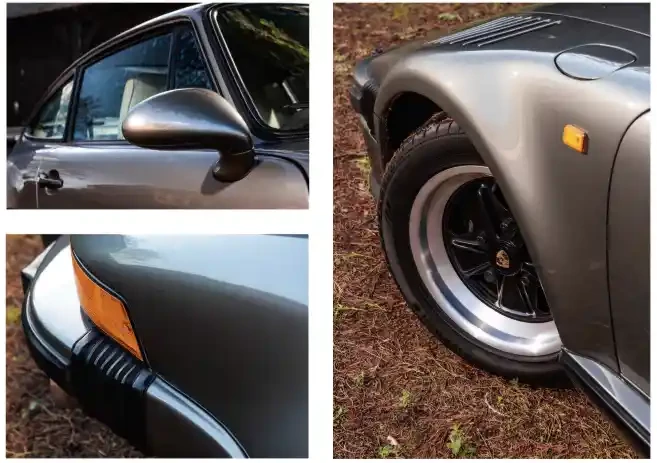
The solid basis for this conversion is a standard 1987 930. The work was carried out by Dage Sport (later known as G-Force), well-known for its lairy Turbo builds and widebody creations in the 1980s and 1990s. The Dage team clearly did a good job, with nothing to suggest this is in any way a nonfactory build, but if the green wide monster looks restrained, then it should be noted Dage sprinkled some its expertise onto the engine of this car, taking it to near 425bhp. While internals are standard (perfectly up to the job), the intercooler is doubled in size. An uprated wastegate and fuel system allows for higher boost pressure. Rather splendidly, a factory 935 adjustable boost gauge replaces the clock in the dashboard, allowing the boost pressure to be set between zero to 2.0 bar. A purposeful twin-outlet exhaust with hundred-millimetre outlets takes care of noise and emissions. Being an early 1987 930, it features the four-speed Type 915 gearbox so integral to the 911 Turbo experience. This particular transmission is complete with a limited-slip differential set at fortypercent lock factor.
DROP EVERYTHING
If you’re thinking this car looks lower than a standard 930, then it will come as no surprise for you to learn the torsion bars have been dropped and uprated Bilstein dampers fitted. Stopping power is up, however, thanks to 993 GT2 brake calipers tucked within the Continentalshod Fuchs. The original ‘flag’ door mirrors have been substituted for later, curvier ‘teardrop’ mirrors (as seen on the 964 Carrera RS), but this Flachbau clone is otherwise as one might expect. For all its 1980s widebody excess, however, when viewed alongside the supersize-me 992 GT3 RS, which measures in at 4,572x1,900mm and weighs 1,450kg, the 930 before us is positively svelte. Thinking about it, the 992 GT3 RS is probably the modern equivalent of this air-cooled classic, particularly when you consider the new model’s wing louvres and aero kit. Fortunately, inside our Flachbau resides none of the outlandish styling the 1980s might have delivered. Electrically operated Linen sports seats, black carpets and an olive-coloured leather dash top to match the Falsen Green exterior is all there is to report. A quick check of the odometer reveals just thirty-four thousand miles covered from new.
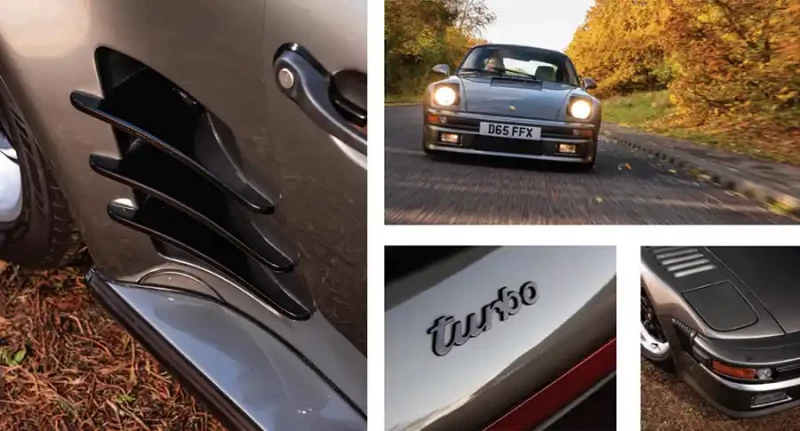
Time for a drive. In some ways, knowing this isn’t the real deal takes a bit of pressure off. The car’s value, while up there, is still significantly below that of a factory Flachbau. This is a good thing — it means the cars next custodian might actually use it. Yes, this terrific Turbo is for sale. Being usable is, of course, the 911 Turbo’s forte. In the supercar poster world of the 1980s, Mr 930 would always be first on the road, while Mr Countach and Mr 512 BB struggled to prime their Webers and warm up their gearboxes (to ensure they could actually select second gear, which is always useful). Hell, Mr Countach would be struggling to climb into his car as the Porsche was already out of sight.
And so it proves in 2023. The utterly untemperamental Turbo starts with its unique and satisfying metallic whoosh-cum-clatter on the first turn of the key. Ensconced in Porsche’s best-ever sports seat, I have no issues with visibility. The pedals, while being slightly odd in that classic-911-floor-mounted way, are at least only slightly offset and soon feel perfectly natural, helped by a clutch not requiring a left leg of steel to activate. Back to talk of gearboxes for a moment — while this Turbo may only have a four-gear transmission, each ratio is easy to engage. Folk moan about the Type 915, but a good one is fine, providing you don’t rush it.
Sticking with this equipment, while the defining feature of the 911 Turbo is, of course, the turbocharger, equal billing should be given to the gearbox. Specifically, the four ratios within. I may have wanged on about this before (actually, there’s no ‘may’ about it), but in terms of performance and how it is deployed, the combination of the turbocharger installation and the chosen gear ratios is absolutely fundamental to the 930 driving experience.
FOUR TO THE FLOOR
Porsche famously and pragmatically stuck with four gears, arguing the abundance of torque on offer would easily drive the four ratios and overcome the inevitable troughs between them. First gear will pull to nearly 60mph, while second will crack 90mph. Third will charge well into three digits. Fourth is really an overdrive or autobahn ratio. Seven-speed PDK, this is not.
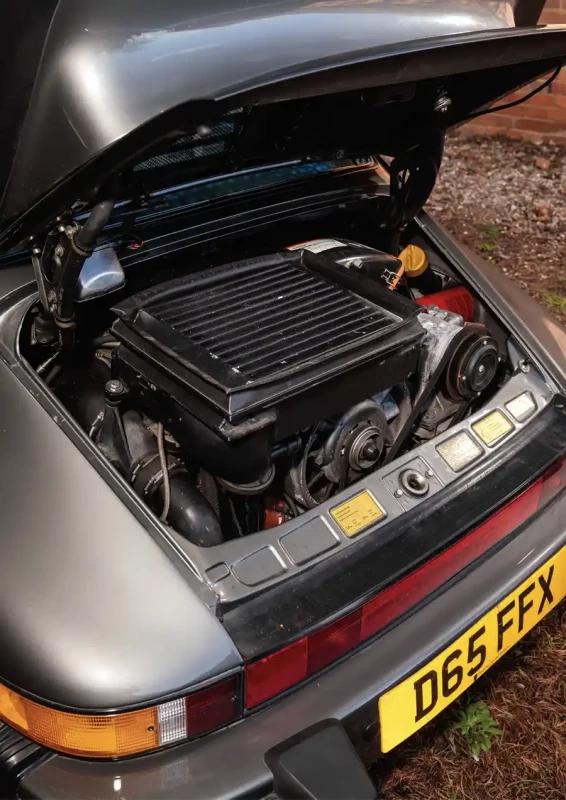
All of which gives the Turbo a distinct Jekyll and Hyde persona. This Porsche will famously trickle along in a high gear on a whiff of throttle and boost, but you need to be at 3,500rpm or beyond in order to activate the full force of its performance,, which in second or third gear, gets really quite explosive. Consequently, in most roadgoing situations, the 930 is pretty much a two-speed car, which sounds kind of mad, but given the range of the ratios, this is how you drive it if performance and progress are to be made. If you were to use fourth in absolute performance terms, you would be changing up from third at more than 120mph, which is really quite sobering. This isn’t something I’m about to try in the Flachbau I’ve been given the keys to, but I’m happy to give this particular Porsche a bit of prod lower down the gearbox. It would be rude not to. There’s also the small matter of an extra 100bhp over the standard output, thanks to Dage’s intervention. Having said this, I don’t want to be the one to tank this Turbo. Boost is therefore set at 1.5 bar, which seems like a ‘sensible’ compromise.
Out on to the quiet backroads around Rind Vehicle Design’s Berkshire base, the Turbo trundles along, just because it can. Let it amble in fourth right down to 30mph, before dropping down to second and slowly lighting up the turbocharger. From 2,500rpm, the boost gauge starts to twitch. By 3,000rpm, there’s a definite shove in the back. Right on cue, 3,500rpm is hammer time — everything starts to happen very quickly. There’s not quite enough road to explore the full performance potential of this Porsche. To max out in second (in excess of 90mph, remember) and keep boosting into third gear would, frankly, be slightly unhinged. This is the 911 Turbo for you. Drivers wonder what all the fuss is about and then all hell breaks loose.
To make proper progress requires anticipation, thereby not being caught off-boost and in the wrong gear. Moving forward, it’s obvious enough — keep the engine in its 2,500-3,500rpm sweet spot and progress is refined and rapid. To be ready for all eventualities, when decelerating, change down to third below 70mph, second below 50mph and first below 30mph. Stick to this regime and there’s always power as and when you want it. It’s certainly a different mindset, but putting it altogether, understanding the relationship between boost and gearing, is part of the skillset of 911 Turbo driver.
Very few cars of the 1980s can do what the 911 Turbo does. It really was a game changer. The real poseurs were the prancing horse and the raging bull. The 930 made them look silly. In Flachbau form, the Turbo also got to pose, but it should be remembered Porsche developed the slant-nose look in the interests of racing, to go harder at Le Mans, not down the King’s Road. The Ferraris and Lambos of the era were hopeless race cars. Indeed, nobody ever really tried, least of all their respective factories.
Ojjeh wished for something different and Porsche was persuaded to accommodate — the Sonderwunsch programme was born. It exists to this day, turning special wishes into reality. There’s always a price for exclusivity, though. It’s a cost remaining high in the present, which is where this car comes in. Some will turn their nose up, but given this Flachbau uses all the right parts, only a real chassis plate spotter would know. I don’t mind admitting I had to be told. This Rindt Vehicle Design sales offering wears its modifications well, and who wouldn’t want a 930 Flachbau with close to 425bhp? As special wishes go, it’s right up there.
Above Side strakes were typical of the 1980s, although Italy’s supercar makers liked them to stretch down the entire side of a car’s body, unlike Porsche, which limited application to intake apertures in the rear quarters Facing page Engine upgrades include a twinelement intercooler, uprated wastegate, higher-flow fuel system and a sport exhaust with twin 100mm outlets. Above With styling inspired by Porsche’s 935 race cars, this Flachbau is sure to delight its next owner, who will doubtless be thankful of the car’s low mileage.
Above and below Like the exterior paintwork, Linen leather is restrained, proving owners don’t need to ‘make a statement’ just because they own a slant-nose 911 Turbo.
Above Flachbau styling continues to divide opinion among Porsche enthusiasts, but it served to position the 911 in a favourable light during the era of excess, when Ferrari and Lamborghini were producing their most outlandish bodywork designs.
Facing page Converted from a standard 1987 930 in the 1990s, this Falsen Green Flachbau features a wealth of upgrades, including engine modifications contributing to output closing in on 425bhp.


